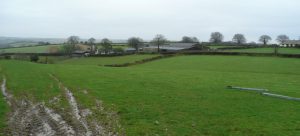Rain may often be a good thing, but if we’re trying to get spring crops in the ground, wet soil can create costly delays.
Spring marches onward amid damp and dreary days, and it’s possible that we’ll have another wet one this season. And while every producer knows that Mother Nature is a fickle fiend even on good days, the NOAA National Weather Service is calling for hot and wet months March through July. And yet, the crops need planting nonetheless, even if we’re forced into planting in wet soil.
Whether this will or will not be a continuing trend in terms of climate change remains to be seen. In the meantime, consider there are some early season tips to keep in mind if facing a wet planting season.
Soil samples
Soil samples are especially important if your fields have been flooded over and moving water has been involved. Lands near large creeks or rivers can undergo rapid shifts in soil nutrients, and even composition over time if enough motion has been involved. Check with your local extension educator and co-op to see if other neighboring landowners have been affected as well.
Pest alert
Weather can certainly play a determining factor in the conditions supporting or limiting pests, and warm, damp ground is great breeding ground for slugs and other pests. Whether through the use of pesticides or some light disc work to move air through the ground, consider formulating a plan of attack before the problem arrives.

Clean up equipment
Proper equipment setup is a crucial component of row residue removal. Clean and grease all mechanisms in advance and prepare for a repeat process if the ground is going to damp and even muddy going forward. Pulling and dragging through the mud can also alter the settings on your equipment.
Consider planting depth
Remember that compaction is real in times of damp soil, and planting depth may need to be altered so as to quicken seed emergency. Check with your local extension service for guidance, but in times of damp weather, somewhere between 1 and 1.25 inches might be the optimum depth.
Planting schedule
One thing farmers learned in 2019 is that timing is everything. During wet seasons, earlier may be better, if possible. Depending on the hybrids involved and how the fields were left after harvest, an earlier plant date helps rather than waiting until mid-June, which many soybean farmers had to do in 2019. Another resource for information on this topic would be your crop insurance specialists who, year in and year out, have had to deal with the ill effects of weather-related damages.
Consider cover crop usage
Farmers employing no-till strategies report better results during wet springs for a number of reasons. In addition to warmer ground, improved soil health and organic matter content, the working of the ground tends to produce better outcomes. The living cover helps suck up moisture, particularly if temperatures are warm enough to kick it into gear, and if the ground has been continuously no-tilled, it tends to be much firmer with less compaction.
Take heart
Keep in mind, this has happened before. By May 26, 2019, only 46 percent of Wisconsin’s corn crop was in the ground compared with 77 percent in 2018 at that date. Only 20 percent of soybeans were in the ground compared with 59 percent year prior. Year in and year out, farmers continue to battle Mother Nature and keep on trucking. That said, trends do appear to be moving in the direction of wetter, warmer springs throughout much of the country and revised schedules and tactics are worthy of consideration going forward.
Brian Boyce is an award-winning writer living on a farm in west-central Indiana. You can see more of his work at www.boycegroupinc.com.



